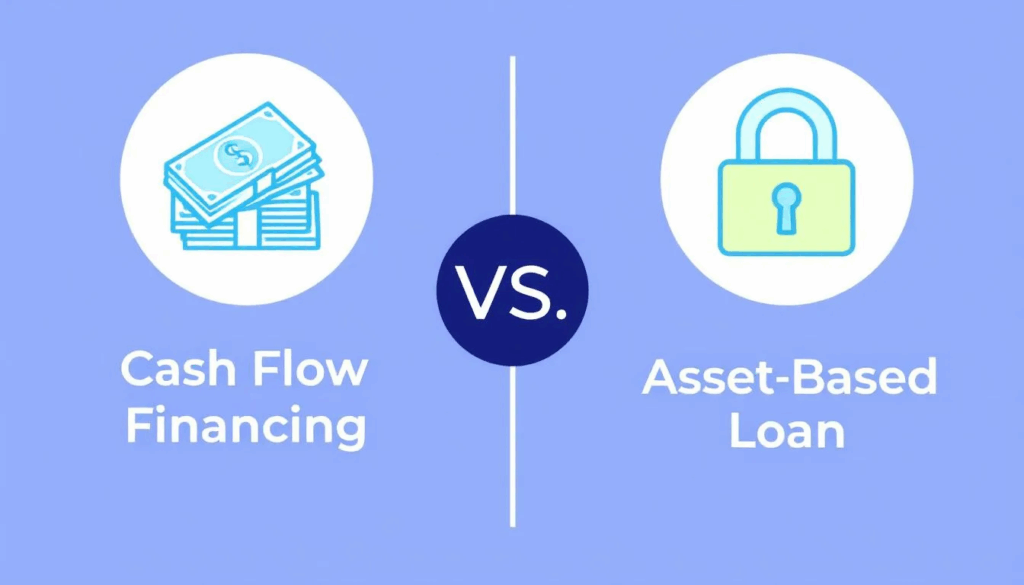What are Cash Flow Loans?
Cash flow loans are various business financing products where lenders base credit approval on future cash flow projections. Small business owners can use the funds from cash flow-based loans for multiple purposes, but they are primarily for working capital needs. Cash flow loans can be used to cover everyday expenses, such as payroll, bills, and inventory.
Since your projected cash flow is the primary determining factor in credit approval, lenders typically accept lower credit scores and a shorter time in business. Most cash flow-based financing options are unsecured loans, meaning you don’t have to pledge collateral. However, some lenders will require a blanket lien or personal guarantee in the loan agreement. Personal guarantees allow lenders to come after your personal assets if you default.
There are some cash flow lending banks, but online and alternative lenders are the primary source of these loans. Most online lenders use fintech solutions to analyze your cash flow quickly, streamlining the application, approval, and funding processes.
Small business owners who choose cash flow lending typically need fast funding to cover urgent cash flow gaps. Some common uses of cash flow loan proceeds include:
- Purchasing inventory or business supplies.
- Hiring new employees or funding temp employment contracts.
- Making payroll.
- Everyday expenses include rent, insurance, and other similar costs.
- Covering a cash flow gap.
What are the different Types of Cash Flow Loans?
Small business owners can apply for several types of cash flow loans:
Short-Term Business Loans
Short-term business loans are a form of traditional term loans, except that the repayment terms are shorter, and the loan amounts are typically lower. Small business owners use short-term loans as a working capital solution. Some lenders can underwrite short-term loans based on cash flow, although most use some form of asset-based financing.
Business Lines of Credit
A business line of credit provides a credit limit from which you can draw funds as needed. You then only repay what you borrowed plus interest and fees. Most lines of credit are revolving, meaning your credit limit replenishes when you repay. Cash flow lenders offer different amounts, rates, and terms for a line of credit.
Merchant Cash Advance
With a merchant cash advance (MCA), borrowers receive a large sum of cash upfront, which is then repaid from a percentage of daily debit and credit card sales. Some lenders use a fixed percentage, while others use flexible terms so borrowers only repay what they can afford.
Revenue-Based Financing
Revenue-based financing is similar to a merchant cash advance, but with a key difference: repayment comes from all revenue sources, not just card payments. This makes it an ideal option for businesses that don’t process a high volume of credit or debit card sales.
You receive a large lump sum based on your previous revenue. The repayment is a fixed or flexible percentage of future revenue, with daily or weekly payments. Some lenders might offer monthly payments, but this is rare.
What are the benefits and drawbacks of Cash Flow Financing?
Cash flow financing can be a powerful tool for small businesses that generate consistent revenue but lack physical assets to pledge as collateral. It allows business owners to leverage their incoming cash flow and overall financial performance to qualify for funding. The advantage of cash flow lending is that financing can be obtained much faster without requiring collateral appraisal or having a stellar credit history.
This type of financing is often used for short-term working capital needs, growth initiatives, or bridging gaps between receivables and expenses. However, it’s essential to weigh the potential downsides. Interest rates for cash flow loans are typically higher than for secured loans due to the lack of physical collateral. Some lenders may also require frequent repayments, which could impact your day-to-day cash position. Missing payments can seriously compromise your business’s financial health.
Cash-Flow Financing Pros & Cons
Pros:
- Provides funding to help support your business.
- Quick and easy applications with minimal documentation.
- Fast funding time, usually within 3 business days or sooner.
- Flexible payment terms.
- Unsecured financing, so you don’t have to provide collateral.
Cons:
- Higher rates and fees than traditional business loans.
- Requires frequent repayment.
- May require a personal guarantee or blanket lien.
- You must have strong cash flow to get approved.
What are Asset-Based Loans?
In asset-based lending (ABL), lenders base credit approval on the value of the assets listed on a company’s balance sheet. Unlike unsecured business loans, small businesses must pledge assets as collateral. In the case of a default, the lender claims the assets to recoup its losses. All ABL loans are secured because they require collateral.
For this reason, ABL lenders prefer highly liquid assets. The amount a company receives for a loan depends on the loan-to-value ratio (LTV). Assets with high liquidity, such as securities, typically have a higher LTV of around 85%, meaning your loan amount will be 85% of the asset’s face value. Physical assets with lower liquidity, such as real property or business equipment, might only yield loan amounts equaling 50% of the asset’s face value.
Examples of collateral used in asset-based loans include:
- Accounts receivable
- Inventory
- Machinery and equipment
- Commercial real estate
- Intellectual property
- Marketable securities
- Purchase orders or contracts
What are the different Types of Asset-Based Loans?
Here are the different types of asset-based lending to consider.
Business Term Loans
Asset‑based business term loans are fixed-sum loans secured by assets such as equipment, inventory, or real estate. They typically provide lump‑sum funding that’s repaid over a set period, often with installments. Because the loan is backed by tangible collateral, interest rates are generally lower than those of unsecured lending, but lenders may require audits or value assessments of the pledged assets. These loans typically have fixed repayment schedules.
Note: Unsecured business term loans can be cash flow financing.
Accounts Receivable Factoring
Also known as invoice factoring, accounts receivable factoring lets businesses borrow against unpaid invoices. The lender advances a percentage—often 80–90%—of the invoice value, and the remaining balance (minus fees) is remitted once customers pay. This financing is ideal for firms needing immediate cash flow while awaiting invoice payments.
Equipment Financing
Equipment financing uses machinery, vehicles, or capital equipment as collateral for a loan. Borrowers receive funds to purchase or refinance assets; the equipment itself serves as security. This type of loan often allows financing up to 100% of the equipment cost, with predictable repayment schedules and relatively lower risk to the lender.
Commercial Real Estate Loans
Loans secured by commercial real estate allow businesses to leverage owned property (like office buildings or warehouses). These are long‑term, generally lower-rate financing options, often used for expansion, refinancing, or redevelopment. Since the collateral is immovable real estate, lenders view it as stable security, though approval may require valuation and property appraisal.
Inventory Financing
With inventory financing, lenders advance funds based on the value of a business’s inventory, goods held for sale or use. It’s handy for retailers or wholesalers needing to purchase or hold stock for seasonal peaks. The inventory itself serves as collateral and can be seized by the lender if repayment fails. Invoice factoring allows businesses to sell their accounts receivable for an immediate cash advance.
What are the benefits and drawbacks of Asset-Based Loans?
Asset-based loans (ABL) offer a practical solution for businesses that own valuable physical or financial assets. These loans allow companies to borrow against those assets, such as accounts receivable, equipment, or inventory, often providing more flexible financing than traditional bank loans. They’re handy for businesses with strong balance sheets but inconsistent revenue.
One significant benefit of asset-based lending is that the collateral is built into the loan, which may lead to lower interest rates compared to unsecured options. On the other hand, the approval process can be more complex. Businesses may need to submit regular reports on their collateral and face limits based on asset value. Also, there’s always a risk of losing the pledged asset(s) if the loan is not repaid as agreed.
Asset-Based Lending Pros & Cons
Pros:
- Businesses with uneven cash flow can get financing.
- The collateral is built into the loans.
- More financing flexibility.
- Leverages equity in your existing assets to gain capital.
Cons:
- Risk of losing the asset(s) if the business defaults.
- Must have significant assets – usually not available for startups.
- Lower LTV for physical assets such as equipment or real estate.
- Must file frequent reports on asset status.
- Asset depreciation could negatively affect available capital.
What are the Key Differences Between Cash Flow Financing & Asset-Based Loans?
Both types of lending can be fast options for growing businesses, but they have different eligibility requirements and risks. Each option can help small businesses secure funding when traditional loans are unavailable.
Cash flow-based lending is evaluated based on the business’s ability to generate cash flow using projected earnings and business performance, while asset-based lending hinges on the value of collateral like receivables, inventory, equipment, or real estate. Asset-based lending involves a due diligence process that may include inspections of financial statements and appraisals.
Cash flow lenders analyze metrics such as EBITDA and future cash flow projections, making it easier for companies with strong margins and minimal physical assets to qualify. Businesses must generate sufficient revenue to repay these loans. For this reason, lenders scrutinize a company’s ability to create consistent revenue streams more carefully.
In contrast, asset-based lenders focus less on earnings and more on the liquidity and value of balance sheet assets. This means asset-rich businesses with uneven or inconsistent cash flow find asset-based loans more accessible. Asset-based structures also tend to include fewer restrictive financial covenants compared to the tight coverage and leverage ratios required in cash-flow lending. Lenders require physical collateral for this option.
When it comes to cost and flexibility, asset-based loans generally offer lower interest rates since the lender has collateral protection, and borrowing capacity often expands as asset value increases. Cash flow financing, by contrast, usually involves higher rates and fee structures, but can provide quicker funds and simpler approvals, especially for businesses without assets to pledge. The availability of asset-based credit fluctuates with asset performance, whereas cash flow loans can be more volatile if earnings weaken.
Asset-Based Lending vs. Cash Flow Financing Compared
| Feature | Cash Flow Financing | Asset-Based Lending |
|---|---|---|
| Collateral Requirement | No physical collateral required; based on earnings and cash flow | Requires tangible assets (AR, inventory, equipment, real estate) as collateral |
| Qualification Metrics | EBITDA, enterprise value, projected revenue | Asset liquidity and value, advance rates based on collateral |
| Approval & Originating Time | Faster, minimal documentation | Slower due diligence process with appraisals and field exams |
| Interest Rates | Typically higher due to higher risk | Lower interest rates, since secured by assets |
| Covenant Structure | Stricter financial covenants tied to cash flow and leverage ratios | Less restrictive covenants; often revolving lines tied to asset performance |
| Borrowing Capacity | Based on future earnings, they may fluctuate | Based on a borrowing base tied to asset value, it can grow with asset accumulation |
How to apply for Cash Flow Financing or Asset-Based Lending:
You can apply for a cash flow or asset-based small business loan through our lender network. Follow these steps to apply:
Step 1: Consider Your Needs
Before you begin the application process, take some time to make sure this is the right product for your individual needs. Will you be able to use the capital for your desired purpose? Is the repayment structure conducive to your cash flow? Do you know exactly how much funding to request?
Answering these questions ahead of time will make the rest of this process much smoother.
Step 2: Gather Your Documents
Documentation requirements vary depending on the cash flow loan you’re requesting. For example, invoice financing will require your Accounts Receivable (A/R) and Accounts Payable (A/P) aging reports. A merchant cash advance requires bank statements showing card payments.
Regardless of the loan, expect to provide these basic documents during the application:
- Driver’s license
- Voided business check
- Bank statements from the past three months
- Financial statements
Step 3: Fill Out the Application
You can begin the application process by calling us or filling out our one-page online application. Either way, you’ll be asked to supply the information from the previous section along with your desired loan amount.
Step 4: Speak to a Representative
Once you apply, a representative will contact you to explain the repayment terms, interest rates, and terms you qualify for. This will ensure that there are no surprises or hidden fees during repayment.
Step 5: Receive Approval
If approved, funds should appear in your bank account in 1-3 business days, depending on your loan type.
Frequently Asked Questions
Here are some of the most common questions about cash flow loans versus asset-based lending.
Is a Cash Flow Loan or an Asset-Based Loan best for my business?
Choosing the right financial strategy between ABL and cash flow loans comes down to your business’s strengths and weaknesses. Each financing method has pros and cons.
Cash flow loans are better for companies with robust revenue streams and projected cash flow growth. Your cash flow must be able to handle the loan repayments without eating into your margins. Service-based companies and technology firms often favor cash flow lending with strong revenue but limited physical assets.
Asset-based loans tend to be more suitable for businesses with a solid historical performance and a robust balance sheet to show for it. In particular, if your company has acquired assets with high liquidity, ABL could be more beneficial.
Companies with large balance sheets are often better suited for asset-based lending than those with high EBITDA margins. Asset-based loans are typically structured as revolving lines of credit. Capital-intensive industries usually benefit from ABL.
Is it easier to qualify for Cash Flow Lenders?
Both cash flow loans and asset-based lending provide alternatives to conventional loans, which are primarily based on the business owner’s personal credit score, time in business, and overall revenue. Businesses with substantial, verifiable cash flow will find qualifying for cash flow loans easier. Companies with limited cash flow but high-value assets will find it easier to be eligible for ABL loans.
Are Cash Flow or Asset-Based Loans better for bad credit?
Both loan types are available as bad credit business loans. However, when seeking business loans with no credit, you want to show lenders how you can mitigate their risks.
Strong cash flow can certainly help, but one of the best ways to offset bad credit is by pledging collateral. For this reason, asset-based lending is better for bad credit, but only if you have the collateral to pledge.
Cash Flow Financing vs. Asset-Based Lending – Final Thoughts
Thanks to online lenders, small business owners have more financing options than ever before. However, knowing the key differences between loan structures can help you choose the best option and avoid loans that could strain your cash flow.
One way to view ABL and cash flow loans is through the lens of how lenders perceive you and your business. ABL lenders consider your business’s performance and the overall equity of your company – the asset you can pledge as collateral. Cash flow lenders also look at what you’ve done, but with an eye towards your future and your cash flow – your company’s ability to earn money is the asset.
Consider cash flow loans if you’re confident in your company’s future and don’t want to risk your assets. ABL might be better if your cash flow is shaky, but you have substantial business assets.
Contact us if you have any questions or want to apply for a small business loan. Our loan executives can help you find the best financing option for your business needs.












